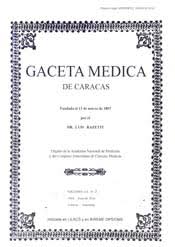Epidemia de fiebre chikungunya en Venezuela, 2014-2015
Contenido principal del artículo
Resumen
Introducción: En 2014 el virus de la fiebre chikungunya
fue introducido en Venezuela. Se produjo una
grave epidemia cuya magnitud y diseminación no
fue informada oficialmente. Objetivo: El estudio
describe los métodos epidemiológicos alternativos de
evaluación y seguimiento empleados para caracterizar
la epidemia y estimar la tasa de ataque. Métodos:
Motivados por la falta de información, utilizamos
el número de casos febriles agudos (CIE. R50) en
exceso, reportados semanalmente y los comparamos
con los valores máximos esperados, tomando como
referencia el canal endémico calculado con los dos años
precedentes; esto permitió identificar la presencia de
chikungunya, como explicación válida, en ausencia
de otras enfermedades febriles agudas. Calculamos
la tasa incidencia acumulada y la razón endémica,
antes y durante el desarrollo de la onda epidémica.
Igualmente obtuvimos las tasas de incidencia acumuladas
por entidades federales y se compararon con los
casos oficialmente clasificados como sospechosos de
la enfermedad. Resultados: Pudimos describir con
precisión la evolución de la onda epidémica y la diseminación
de la enfermedad a todo el territorio nacional.
Así mismo este abordaje permitió estimar el impacto
general y regional sobre la población, con una tasa
de ataque en 2014, entre 6,9 % y 13,8 %, mucho más
grave y diseminado que lo informado por el MPPS.
Conclusión: El estudio logró una más precisa caracterización
de la epidemia y puso en evidencia fallas
de planificación, vigilancia y control aplicados, (entre
ellos, el retraso y la pobre calidad de los registros),
herramientas claves para reducir el impacto de esta
enfermedad emergente sobre la población.
Palabras clave: Chikungunya; Enfermedades infecciosas
emergentes; Fiebre aguda; Tasas de Incidencia;
Métodos de estimación de enfermedades epidémicas;
Vigilancia y control de enfermedades virales.
SUMMARY
Introduction: The chikungunya virus was introduced
in Venezuela in 2014. There was a serious and epidemic
outbreak whose magnitude was not officially informed.
Objective: The study described alternative methods
of epidemiological evaluation and monitoring used
to characterize the epidemic and estimate the attack
rate. Methods: Motivated by the lack of information,
we use the number of acute febrile cases (ICD. R50)
in excess, weekly reported and compared them with
the maximum expected values, with reference to the
endemic data calculated within the preceding two
years. This allowed us to identify the presence of
chikungunya as a valid explanation, in the absence
of other acute febrile illnesses. We estimated the
cumulative incidence rate and endemic proportion,
before and during the development of the epidemic
wave. Also we obtained cumulative incidence rates
by Federal entities in Venezuela and compared them
with officially classified data as suspected cases of the
disease. Results: We were able to accurately described
the evolution of the epidemic wave and the spread of
the disease throughout the country. Also this approach
allowed us to estimate the general and regional impact
on the population, with an attack rate in 2014,
between 6.9 % and 13.8 %, much more serious and
widespread than reported by the MPPS (Ministerio
del Poder Popular para la salud). Conclusion: The
study achieved a more accurate characterization of
the chikungunya epidemic and highlighted failures of
planning, monitoring and applied control (including
delays and poor quality of records), key tools to reduce
the impact of this emerging disease on the population.
Key words: Chikungunya; emerging infectious
diseases; acute fever; Incidence Rates; Methods of
estimation of epidemic diseases; Surveillance and
control of viral diseases.
